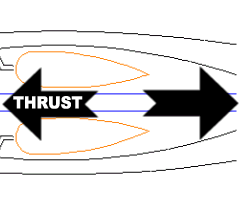Rocket The rocket engine is the simplest of this family. In order to work in outer space, rocket engines must carry their own supply of oxygen as well as fuel. The mixture is injected into the combustion chamber where it burns continuously. The high-pressure gas escapes through the nozzle, causing thrust in the opposite direction.
The rocket engine is the simplest of this family. In order to work in outer space, rocket engines must carry their own supply of oxygen as well as fuel. The mixture is injected into the combustion chamber where it burns continuously. The high-pressure gas escapes through the nozzle, causing thrust in the opposite direction.
Turbojet
The turbojet employs the same principle as the rocket. It burns oxygen from the atmosphere instead of carrying a supply along. Notice the similarities: Fuel continuously burns inside a combustion chamber just like the rocket. The expanding gasses escape out the nozzle generating thrust in the opposite direction.
Notice the similarities: Fuel continuously burns inside a combustion chamber just like the rocket. The expanding gasses escape out the nozzle generating thrust in the opposite direction. Now the differences: On its way out the nozzle, some of the gas pressure is used to drive a turbine. A turbine is a series of rotors or fans connected to a single shaft. Between each pair of rotors is a stator -- something like a stationary fan. The stators realign the gas flow to most effectively direct it toward the blades of the next rotor.
Now the differences: On its way out the nozzle, some of the gas pressure is used to drive a turbine. A turbine is a series of rotors or fans connected to a single shaft. Between each pair of rotors is a stator -- something like a stationary fan. The stators realign the gas flow to most effectively direct it toward the blades of the next rotor. At the front of the engine, the turbine shaft drives a compressor. The compressor works a lot like the turbine only in reverse. Its purpose is to draw air into the engine and pressurize it.
At the front of the engine, the turbine shaft drives a compressor. The compressor works a lot like the turbine only in reverse. Its purpose is to draw air into the engine and pressurize it. Turbojet engines are most efficient at high altitudes, where the thin air renders propellers almost useless.
Turbojet engines are most efficient at high altitudes, where the thin air renders propellers almost useless.
Multiply Commerce
14 years ago




0 Comments:
Post a Comment